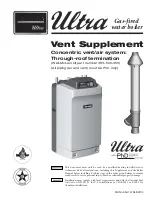
-Provide a minimum 5 cm gap to be between top point of the fuel and ceiling of stoking chamber when
boiler is stocked.
8.4
O
VERNIGHT HEATING MODE
This mode i sused when you want to maintain the fire in the boiler for instance oven night.First
csarpe all ash out the combustion chamber,with the chimney flap completly opened.Then stoke the boiler with
fuel and shut the boiler up completly.Then shut the chimney flap and also almost shut the regulating
hatch.This will reduce the chimney thrust and restrict the supply of combustion air.Shut also the secondary
air supply rosette in the stoking door.To restore the boiler´s required output,just open the chimney flap and
partially open the regulating hatch to the required boiler output.
8.5
R
EMOVING SOLID COMBUSTION RESIDUALS
This is done by removing and emptying the ashtray situated under meath the stoker in the ash
comparment.This must be done on a regular basis to prevent ash from accumulatining and blocking the
supply of air to the combustion chamber from under meath the stoker.
8.6
D
EWING AND TARRING
When starting fire in a cold boiler ,water condensates on the walls and runs down into the ash
compartment,which may make an impression that the boiler is leaking.This dewing will disappear after the
astray has settled on the boilers inside walls.When running the boiler with low water temperature usually below
65 C or when using damp fuel, water condensastes in combution gases and the condensate runs down the boiler´s
cold walls.Low temperature heating also reduces the chimney life.There fore it is recommended to equipt the
boiler with forinstance four-way blending valve whitch will ensure that the temperature of return water does not
drop below 50 C.Boiler tarring occurs under similar conditions (lack of combustion air,the boiler is
choking).To prevent dewing and tarring ,we recommend you run the boiler at temperatures higher than 65 C
and choose a boiler to match the required heating system output .An oversized boilers suffers unnecessarily,
because it has to be run at low temperatures.
8.7
B
OILER SHUTDOWN
We do not recommend that you try to speed up the boiler combustion process.The fuel must burn
completly on its own on the stoker.
8.7.1
Short term shut down
After shutting the boiler down,clean it remove all combustion residuals,empty the ashtray,clean the
stoking door contact surfce and the ash comparment ,and then shut the boiler´s stoking door and ash
comparment door.
8.7.2
Long term shudown
When shutting the boiler down for a protracted period of time(heating season end),the boiler must be
throughtly cleaned from all soot and ash sediments,in whitch dampness accumulates and causes excessive
corrosion of the boiler body.
8.7.3
Important information
-The boiler may only be operated by an adult person familiary with thees operating instructions,
-Shut the boiler down everytime there are any(even temporary ) flamable or explosive fumes present on the
premises from whitch combustion air is supplied to the boiler (e.g.From paint when painting,laying
and spraying molten substances,from gas leakage,etc.)
-It is forbidden to light the boiler with explosive substances.
-It is forbidden to overheat the boiler.
-At the end of the heating season the bolier,flue and flue adapter,must be throughtly cleaned.Lubricate
all hinges,the flap mechanism and other moving.
9
BOILER CLEANING
When the boiler is sused,soot and fine ash accumulates on the boiler walls,mainly on heat exchanger ribs
and in the flue neck,which reduces heat transfer and the boiler output.The actual quantity of soot and fine ash
will depend on the quality of the fuel used and on the boiler operating conditions.If the boiler is oversized or
was forsome reason run at low temperatures,more soot is generated.This may also result in inadequate
cimney thrust.The boiler must be cleaned regulary,at least once a month, which is done with a steel brush
through an open boiler door.After taking front section plate off,all boiler walls inside the combustion chamber
and combustion gases routes should be cleaned.If a large quality of tar has accumulated on internal walls of





































